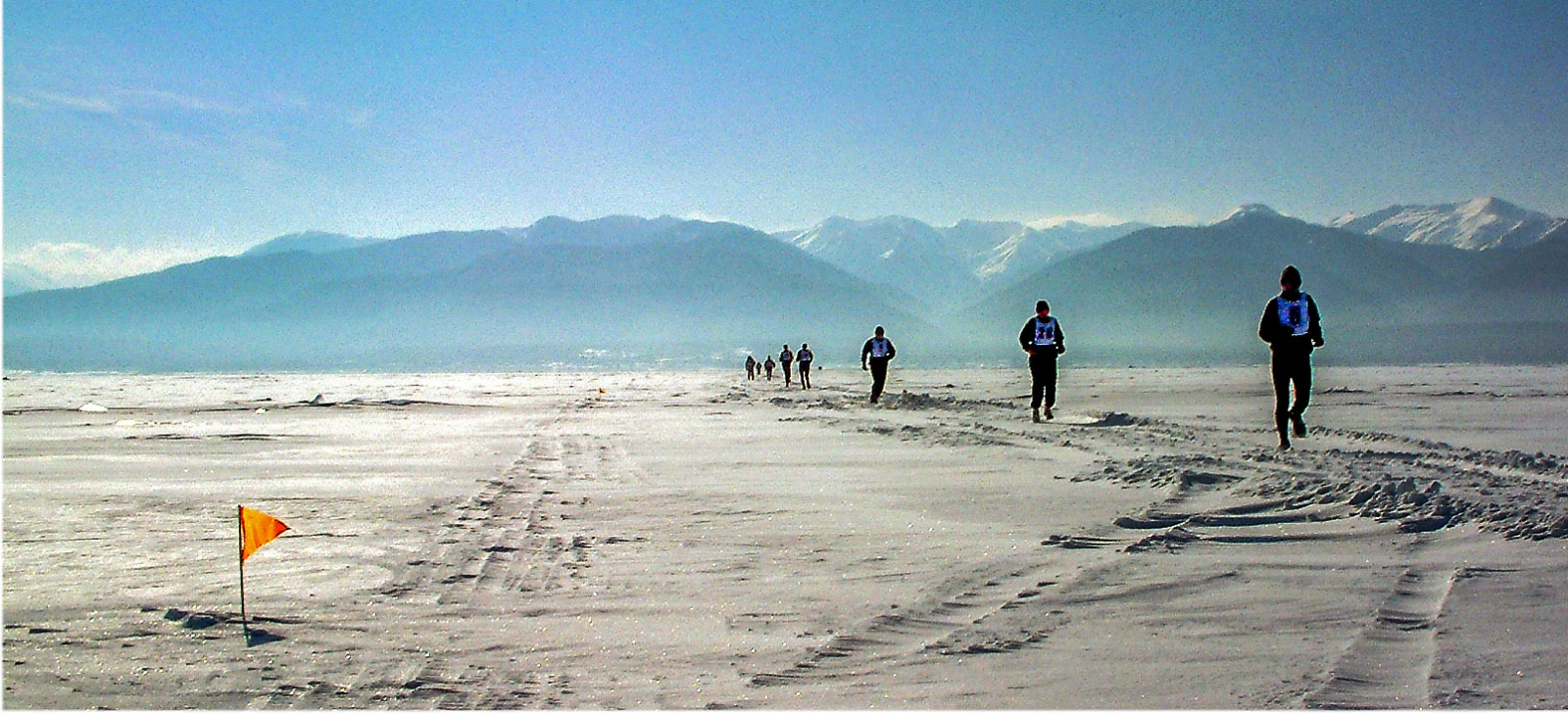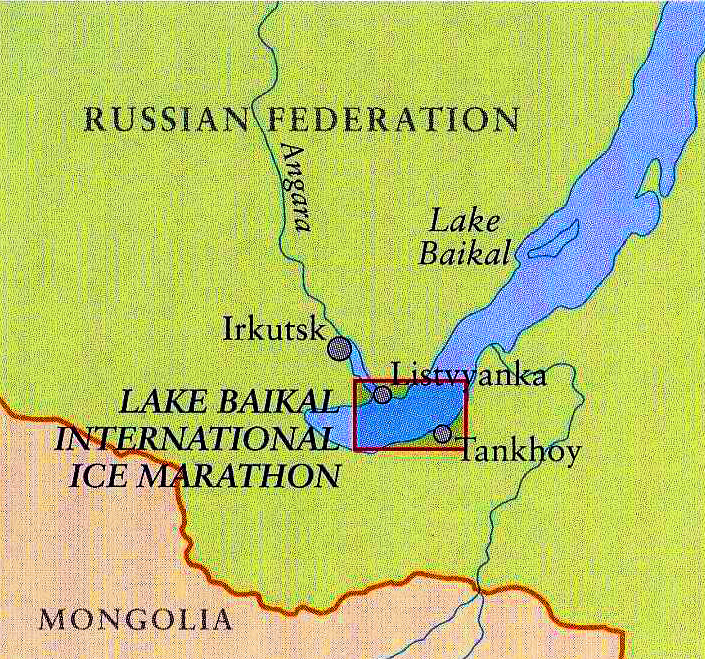Extreme Running by Kim McConnell and Dave Horsley

LAKE BAIKAL
INTERNATIONAL
ICE MARATHON
THE LAKE BAIKAL International Ice Marathon offers competitors the unique opportunity to race across the frozen ice surface of the largest and deepest fresh water lake in the world. The event takes place in an extraordinary isolated part of Russia. It is based ina small town of Listvyanka, 65 km south of Irkutsk ( a stopover on the Trans-Siberian route).
BELOW: Competitors are monitored with the aid of a hovercarf

The Marathon is just a small part of a larger winter games festival, the “Winteriada”, which includes a swimming race in the frozen lake.
Lake Baikal is vast – at 636 km by 70km-and extraordinary deep at 1,637 m. It is repository of a fifth of the world’s unfrozen fresh water. It is estimated that th lake holds sufficient water to supply drinking water for every human for a period of 50 years.
The surface of the frozen lake is covered in fileds of ‘hummocks’, small hills of ice rubble. Beneath the ice surface, geothrmic sprinhs and seismic activity cause localized melting that weakens the ice to form holes. The
| KEY DATA |
| RACE: Lake Baikal International Ive Marathon |
| LOCATION: Lake Baikal ( Listvyanka, Russia) |
| DISTANCE: 42.2km ( 26 miles), single stage |
| DATE: March |
| TOTAL ASCENT: Negligible |
| TOTAL DESCENT: Negligible |
| KEY CHARACTERISTICS: Marathon on frozen surface of world's largest and deepest fresh-water lake |
| RACE RECORDS: Male 3:08, Female:3:54 |
| FIELD ( APPROX): 30 |
| CLIMATE:- 5ºC to 2ºC ( 23ºF to 35ºF) |
| FINISHERS: 75-80 % of starters |
| WEB: www.baikal-marathon.org |
race ‘Ice Captain’ and his team of volunteers have the task of plotting a safe course. They do so the day immediately preceding the race, otherwise movements in the ice would render their effort redundant.
On race day itself, competitors are ferried by van from Listvyanka to Tankhoy train station, located on the opposite shore of Lake Baikal. Prior to the start of the race, competitors are required to partake in the precautionary ritual of ‘vodka sprinkling’, in order to pacify the spirits of the Lake ( introducing the novel element of starting a marathon with a shot of vodka).of plotting a safe course. They do so the day immediately preceeing the race, otherwise movements in the ice would render their efforts redundant.
The course is predominantly flat, but the surface is hard and uneven. Although it is mostly covered in a soft layer of snow, there are areas of highly polished ice that create conditions similar to an ice-rink. Strong winds add to the already bitingly cold temperature and provide serious resistance to progress across the Lake.
The utterly featureless landscape gives little or no sense of perspective to competitors. The finish line at the port of Listvyanka can be seen alsmost from the start line. It is a long, cold, lonely 42.2 km trail across the barren white landscape, where progress is marked only by checkpoints positioned at 5 km intervals ( with hot drinks, food, and, for the brave, more  vodka).
vodka).
The far reaches of Siberia may not be a first choice destination for many endurance athletes, who may prefer instead the warmer, and more glamorous, climes. But for those that brave the Russian winter. The reward is a fantastic race, in an area of outstanding natural beauty, on a one-off running surface.
‘There are only a few places in the world where you can run a marathon on ice. On Lake Baikal it was harder than on Yukon in Canada.’ - Udo Mueller (6th place finisher,2005)
.jpg)
EXTREME RUNNING . The book takes the reader on an amazing world tour of ultra foot races, profiling 24 of the most challenging, exciting and notorious long distance running events in the face of our Planet Earth ( 3 to 4 races per continent including Baikal Ice Marathon in Asia chapter of the book ).
Extreme Running by Kym McConnell and Dave Horsley (Pavilion, 2007, $26.60 at Amazon) is probably the first coffee- table book specifically for ultrarunners.
The book covers a remarkable variety of events, and there is something here for every ultrarunner. There are road ultras , including Badwater, Comrades and Spartathlon, trail ultras such as the Ultra-Trail Tour du Mont-Blanc, Kepler Challenge and Wasatch Front 100 Mile, trail and mountain marathons – Pikes Peak, Inca Trail, Lake Baikal, Antarctica, and multi-day stage races – the Marathon des Sables, Transalpine-Run, and more. Detailed descriptions give a good sense of the total experience of each race, often including pre- and post-race activities. Key data for each race is listed, such as race distance, altitude gain and loss, climate, course records, approximate field size and
finishing rate, and web site and contact information. Coverage of the races ranges from two pages (Pikes Peak, Comrades), up to an in-depth description of the Marathon des Sables in sixteen pages. Each description is loaded with valuable information, maps and eye-popping photos.
The book includes four multi-day, self-sufficiency races which are all very similar in format to the Marathon des Sables. In these events competitors must carry all their own gear, usually excluding only water, and live in spartan conditions during the race. They are uniformly six-day runs of 200-250 km total distance, with one especially long stage of 80 km for which two days are allotted, so that the stage may be completed in a single push or with an overnight sleep break. All are held in extreme environments, such as deserts or the Amazon jungle. The events described here (Marathon des Sables, Gobi March, Jungle Marathon, Atacama Crossing) are not the only ones of this format, and the proliferation of these events is perhaps surprising, especially given entry fees in the range of $3000 to over $5000. But, it surely reflects the desire many of us feel for a truly unique adventure that challenges the body and spirit on many levels. Completing such a trial gives one a sense of confidence that the challenges of daily life can be met and surmounted with grace.
Extreme Running is a great gift for any ultrarunner or serious outdoor adventure junkie, though a spouse or parent may want to think twice before giving their endurance-addicted loved one any more crazy ideas.
________________________________________________________________________________
Extreem lopen
K. MacConnell, D. Horsley, Jonas de Vries
In dit boek worden 24 verschillende vormen van extreem lopen besproken. Er komen een aantal ultralopen aan bod, maar ook wedstrijden op extreme locaties, van de hoogste tot de laagste, de zuidelijkste tot de noordelijkste en de warmste tot de koudste loopwedstrijden ter wereld. Extreeem lopen voert de lezer mee naar ultraloopevenementen en marathons over de hele wereld. Het boek behandelt de voorbereidingen, de uitdagingen, de strategieën en de anekdotes van de mensen achter de race. Verdeeld in zeven hoofdstukken behandelt Extreem lopen bekende races zoals de afmattende Marathon des Sables en de Badwater Marathon, maar ook minder bekende evenementen, zoals de Te Houtaewa Challenge op het schitterende 90 Mile Beach in Nieuw-Zeeland en de Baikal International Ice Marathon, een race die in zijn geheel op bevroren water wordt gelopen. De informatie wordt geïllustreerd met meer dan 150 foto’s en kaartjes.
Auteur
K. MacConnell, D. Horsley
Vertaler: Jonas de Vries
